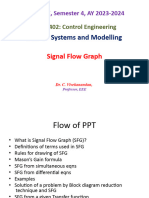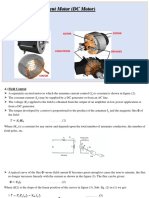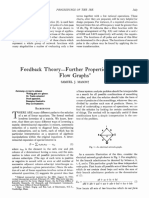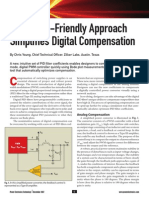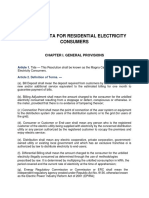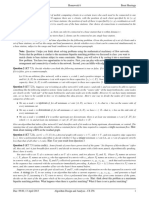Module 3
Module 3
Uploaded by
SohnCopyright:
Available Formats
Module 3
Module 3
Uploaded by
SohnOriginal Title
Copyright
Available Formats
Share this document
Did you find this document useful?
Is this content inappropriate?
Copyright:
Available Formats
Module 3
Module 3
Uploaded by
SohnCopyright:
Available Formats
CHAPTER II: SIGNAL FLOW GRAPH
For complex control systems, the block diagram c. Mixed Node – A node that has both incoming and
reduction technique is cumbersome. An alternative method outgoing branches
for determining the relationship between system variables
has been developed by Mason and is based on a signal flow 2. Branch ─ use to represents transfer function (or blocks).
graph. Signal Flow Graph is a pictorial representation of the It is a unidirectional path that relates the dependency of
simultaneous equations describing a control system. It a control input to an output and vice-versa. (G)
graphically displays the transmission of signals through the
system, as does the block diagram. A signal flow graph is a
3. Path ─ it is a continuous, unidirectional succession of
diagram consisting of nodes that are connected by branches.
A node is assigned to each variable of interest in the system, branches along which no node is passed more than
and branches are used to relate the different variables. The once.
main advantage for using SFG is that a straight forward a. Forward Path ─ path from input node to output
procedure is available for finding the transfer function in node.
which it is not necessary to move pickoff point around or to b. Feedback Path ─ path from output node to input
redraw the system several times as with block diagram node.
manipulations. It is easier to draw and therefore easier to
c. Self-Loop ─ Feedback loop consisting of a single
manipulate than the block diagram.
branch
Mason’s rule is useful for solving relatively d. Loop – a closed path that originates and terminates
complicated block diagrams by hand. It yields the solution to at the same node. (Note: along the path, no node
the graph in the sense that it provides an explicit input-output should be touched twice)
relationship for the system represented by the diagram. The
advantage as compared to path-by-path reduction is that it is 4. Branch Gain/Transmission Function ─ it refers to the
systematic and algorithmic. value of the transfer function (or block) in traversing from
one node to the next.
SIGNAL FLOW GRAPH ELEMENTS a. Path Gain ─ product of branch gains encountered
in traversing a path
R(s) G(s) C(s)
b. Loop Gain ─ product of the branch gains in
traversing a loop
1. Node ─ use to represent control signals. It is a junction SIGNAL FLOW GRAPH ALGEBRA
denoting a variable or a signal. (R, C)
1. ADDITIVE RULE ─ when the value of the variable
a. Input Node or Source Node ─ a node with only designated by a node is equal to the sum of all signals
outgoing branches entering the node.
b. Output Node or Sink Node ─ node with only
R1
incoming branches. G1
Note: R2 G2
Very often, a variable in a system is a function of the
output variable. The canonical feedback system is an G3 C
obvious example. In this case, if the signal flow graph were R3
to be drawn directly from the equations, the “output node” : Gn
would require an outgoing branch, contrary to the definition. .
This problem may be remedied by adding a branch with a Rn
transmission function of unity entering a “dummy” node.
2. TRANSMISSION RULE ─ the value of the variable c. Connect the nodes by the appropriate branches.
designated by a node is transmitted on every branch d. If the desired output node has outgoing branches, add
leaving that node. a dummy node and a unity branch gain.
e. Rearrange the nodes and/or loops in the graph to
C1 achieve maximum pictorial clarity.
G1
C2 2. Block Diagram to SFG
G2 1 G 1
R G C
R C3 C
G3 R
±
H ±H
Gn
Cn
MASON’S GAIN FORMULA
Formula that gives the transfer functions from the source
node to the sink node only.
3. MULTIPLICATION RULE ─ A cascade connection of
n-1 branches with transmission functions can be 1 P
replaced by a single branch with transfer function equal T M K K
K 1
to the product of the old ones.
1
G1 G2 … Gn ( M 1 1 M 2 2 M P P
R X1 Xn C
where:
G1G2…G T = the general input-output gain (C/R) or transfer function
n
from the input node to the output node.
R C MK = Path gain of the Kth forward path
P = no. of paths from input to output
Δ = (signal flow graph determinant or characteristic
CONSTRUCTION OF SIGNAL FLOW GRAPH
function)
= 1 ─ (sum of all individual loop gains) + (sum of the
1. Describing equations to SFG
product of the loop gains of all possible combinations of
nontouching loops taken 2 at a time) ─ (sum of the
a. Write the system of equations in the form
product of the loop gains of all possible combinations of
nontouching loops taken 3 at a time) + …
X 1 G11 X 1 G12 X 2 G1n X n ΔK = value of Δ for that part of the flow graph not touching
X 2 G21 X 1 G22 X 2 G2 n X n the Kth forward path. (also called as the cofactor of Kth
path)
X m G m1 X 1 G m 2 X 2 G mn X n Note:
where: 1. Two loops, paths, or a loop and a path are said to be
X = nodes nontouching if they have no nodes in common.
G = Transfer function 2. To determine ΔK, redraw the flow graph with all the
Note: nodes of the Kth forward path removed.
X1 is not required if X1 is an input node
b. Arrange the m or n (whichever is larger) nodes from
left to right. The nodes may be rearranged if the
required loops later appear too cumbersome.
Example:
Construct the equivalent signal flow graph of the
given block diagrams.
H3
─
+ + +
G1 G2 G3
R C
─ ─
H2
H1
R1 R3 R5
IO1 IO3
Vi Vo
R2 R4 R6
IO4
IO2
For each of the following signal flow graphs, determine:
a. Individual loop gains
b. Forward path gains
c. The value of Δ
d. The value of Δk
e. The transfer function, T
G6 H6
1 G1 G2 G3 G4 G5 1
R C
H1 H2 H3 H4 H5
G7 G5
H2
G1 G2 G3
R
X1 X2 C
─H2
You might also like
- Shortest Path ProblemDocument10 pagesShortest Path ProblemNaveen AngadiNo ratings yet
- Aspects of Combinatorics and Combinatorial Number Theory - NodrmDocument180 pagesAspects of Combinatorics and Combinatorial Number Theory - Nodrmarkaprava paul100% (1)
- Chapter Ii: Block Diagrams in Control Systems Engineering: G(S) G G G GDocument4 pagesChapter Ii: Block Diagrams in Control Systems Engineering: G(S) G G G GJeffry GigantoNo ratings yet
- Lecture 3 BDDocument39 pagesLecture 3 BDhabtemariam woredeNo ratings yet
- Control Systems NotesDocument18 pagesControl Systems NotesBoyang QinNo ratings yet
- Unit1 Block DiagramDocument75 pagesUnit1 Block DiagramPrasidha PrabhuNo ratings yet
- Rambo 1993Document6 pagesRambo 1993brandonwucnNo ratings yet
- 003 ME31002 - Block Diagram-2021febDocument54 pages003 ME31002 - Block Diagram-2021febShek Yu LaiNo ratings yet
- Control Sys.2Document102 pagesControl Sys.2Salman TariqNo ratings yet
- Mechanical Engineering Control-Engineering Signal-Flow-Graph NotesDocument20 pagesMechanical Engineering Control-Engineering Signal-Flow-Graph NotesMarvin IlaoNo ratings yet
- Mechanical Engineering Control-Engineering Signal-Flow-Graph NotesDocument20 pagesMechanical Engineering Control-Engineering Signal-Flow-Graph NotesManjit SahuNo ratings yet
- Block DiagramDocument75 pagesBlock DiagramJane Erestain BuenaobraNo ratings yet
- Unit I - Systems and Modelling: B.E., EEE, Semester 4, AY 2023-2024Document20 pagesUnit I - Systems and Modelling: B.E., EEE, Semester 4, AY 2023-2024Dr. C. V.No ratings yet
- Signal Flow GraphDocument34 pagesSignal Flow GraphsuseelaksmanNo ratings yet
- Signal FlowDocument34 pagesSignal FlowANKUSH 17BEC0253No ratings yet
- On Signal Flow Graph Signal Flow GraphDocument20 pagesOn Signal Flow Graph Signal Flow Graphrub786No ratings yet
- 2018 EE305 New SolutionDocument25 pages2018 EE305 New SolutionJasa R ChoudharyNo ratings yet
- TOPIC 3 - Control-EngineeringDocument35 pagesTOPIC 3 - Control-EngineeringCllyan ReyesNo ratings yet
- LNA Design Uses Series Feedbackto Achieve Simultaneous Low Input VSWR and LowDocument5 pagesLNA Design Uses Series Feedbackto Achieve Simultaneous Low Input VSWR and LowphilippebNo ratings yet
- Lecture 2-Block Diagram Reduction TechniquesDocument71 pagesLecture 2-Block Diagram Reduction TechniquesNoor AhmedNo ratings yet
- Block Diagram Reduction TechniquesDocument59 pagesBlock Diagram Reduction Techniquesdavid.barodi12No ratings yet
- EE4262: Digital and Non-Linear Control: Block DiagramsDocument53 pagesEE4262: Digital and Non-Linear Control: Block Diagramsyessa gamuedaNo ratings yet
- Ic6703 Cs QBDocument25 pagesIc6703 Cs QBsunil1237No ratings yet
- Analysis and Comparison of Universal GMC Biquad StructuresDocument6 pagesAnalysis and Comparison of Universal GMC Biquad StructuresTomina FabiolaNo ratings yet
- AnalogICdesign-chapter6 - Frequency Reponse of AmplifiersDocument29 pagesAnalogICdesign-chapter6 - Frequency Reponse of AmplifiersPhạm Đức ThuậnNo ratings yet
- Chapter 2 - Reduction of Multiple SystemDocument46 pagesChapter 2 - Reduction of Multiple SystemHaqeemee HusseinNo ratings yet
- Transfer FunctionsDocument9 pagesTransfer Functionsjoker princeNo ratings yet
- Comm Net Exercise 2 SolutionsDocument9 pagesComm Net Exercise 2 SolutionsSelma (Student) KheliliNo ratings yet
- Control Lec 5Document31 pagesControl Lec 5Mhabad ZebariNo ratings yet
- IntroductionDocument31 pagesIntroductionWagner SilvaNo ratings yet
- Block Diagram Reduction MethodsDocument70 pagesBlock Diagram Reduction MethodsMuhammad Ahmad AliNo ratings yet
- Lecture 4 Block Diagram Representation of Control SystemsDocument63 pagesLecture 4 Block Diagram Representation of Control SystemsStieve NjorogeNo ratings yet
- Topic Signal Flow GraphDocument34 pagesTopic Signal Flow GraphAisha KhanNo ratings yet
- Lecture - 2 Block Signal FlowDocument77 pagesLecture - 2 Block Signal Flowkibwe anthoNo ratings yet
- Control Reduction - Examples - Lecture 3Document56 pagesControl Reduction - Examples - Lecture 33re0oooNo ratings yet
- 2.block Diagrams and SFG L14Document13 pages2.block Diagrams and SFG L14VijayKumarNo ratings yet
- Feedback Theory - Further Properties of Signal Flow Graphs - SAMUEL J. MASONDocument7 pagesFeedback Theory - Further Properties of Signal Flow Graphs - SAMUEL J. MASONCristhian Moscoso AchahuancoNo ratings yet
- Modelling Electromechanical Systems (Ch. 3)Document27 pagesModelling Electromechanical Systems (Ch. 3)Irtiza IshrakNo ratings yet
- Chapter 2 - Reduction of Multiple SystemDocument22 pagesChapter 2 - Reduction of Multiple SystemAliffNo ratings yet
- Chapter 2 - Reduction of Multiple SystemDocument22 pagesChapter 2 - Reduction of Multiple SystemMustafa ManapNo ratings yet
- Pic Graphics L.C.D. Scope: Ccoonnssttrruuccttiioonnaall PprroojjeeccttDocument5 pagesPic Graphics L.C.D. Scope: Ccoonnssttrruuccttiioonnaall PprroojjeeccttAllahrakha LambooNo ratings yet
- Transfer Functions 2Document7 pagesTransfer Functions 2joker princeNo ratings yet
- MT 218Document3 pagesMT 218graham davidgeNo ratings yet
- Lecture06 Signal Flow GraphDocument13 pagesLecture06 Signal Flow GraphSai AdarshNo ratings yet
- GRL Book-Chapter 5-GNNsDocument21 pagesGRL Book-Chapter 5-GNNsyouesNo ratings yet
- LOGARITHMIC LOOK AHEAD ADDER WriteupDocument5 pagesLOGARITHMIC LOOK AHEAD ADDER WriteupshwetabhagatNo ratings yet
- An Analog-Friendly Approach Simplifies Digital CompensationDocument4 pagesAn Analog-Friendly Approach Simplifies Digital CompensationARob109No ratings yet
- Linear Control SystemsDocument76 pagesLinear Control SystemsKamran TariqNo ratings yet
- A 7-Decades Tuning Range CMOS OTA-C Sinusoidal VCO: Teresa Serrano-Gotarredona and Bernabé Linares-BarrancoDocument4 pagesA 7-Decades Tuning Range CMOS OTA-C Sinusoidal VCO: Teresa Serrano-Gotarredona and Bernabé Linares-Barrancokaran007_mNo ratings yet
- Eecs 160a MT Sol 2007Document8 pagesEecs 160a MT Sol 2007Spencer Xian FergusonNo ratings yet
- Block Diagram - TF - Steady State ErrorsDocument93 pagesBlock Diagram - TF - Steady State ErrorsTarek A-RNo ratings yet
- 3.3 Distributed Execution: Relu Dadd DreluDocument5 pages3.3 Distributed Execution: Relu Dadd DreluSkata TeelNo ratings yet
- Rev. 1973/2.0 Model of 1973: Operator's ManualDocument8 pagesRev. 1973/2.0 Model of 1973: Operator's ManualgregNo ratings yet
- Hanani Abd Wahab BDA 3073 16 July 2008Document34 pagesHanani Abd Wahab BDA 3073 16 July 2008Hafzal GaniNo ratings yet
- Chapter3 (BlockDiagramReduction)Document59 pagesChapter3 (BlockDiagramReduction)Nischal MaharjanNo ratings yet
- BRSummer 17 Flash ADCDocument5 pagesBRSummer 17 Flash ADCahmed hamdyNo ratings yet
- BlockDiagram and Signal Flow GraphsDocument29 pagesBlockDiagram and Signal Flow GraphsDienies TorresNo ratings yet
- Exp - No:9 Design and Implementation of Lag, Lead Compensator AimDocument10 pagesExp - No:9 Design and Implementation of Lag, Lead Compensator AimramjiNo ratings yet
- PPTPRITYDocument27 pagesPPTPRITYPrity kumariNo ratings yet
- Old Question Paper Control SystemsDocument7 pagesOld Question Paper Control SystemsSatendra Kushwaha100% (1)
- Chapter 2 (Print)Document14 pagesChapter 2 (Print)666aokiNo ratings yet
- Analog Dialogue, Volume 48, Number 1: Analog Dialogue, #13From EverandAnalog Dialogue, Volume 48, Number 1: Analog Dialogue, #13Rating: 4 out of 5 stars4/5 (1)
- Module 3Document20 pagesModule 3SohnNo ratings yet
- Module 4Document4 pagesModule 4SohnNo ratings yet
- Module 5Document10 pagesModule 5SohnNo ratings yet
- SyllabusDocument8 pagesSyllabusSohnNo ratings yet
- Module 1Document20 pagesModule 1SohnNo ratings yet
- Module 5Document4 pagesModule 5SohnNo ratings yet
- Module 1Document9 pagesModule 1SohnNo ratings yet
- Lesson 2 Ckts2Document44 pagesLesson 2 Ckts2SohnNo ratings yet
- EE More Objectives No AnswerDocument93 pagesEE More Objectives No AnswerSohnNo ratings yet
- Math 111: Summary of Trigonometric IdentitiesDocument1 pageMath 111: Summary of Trigonometric IdentitiesJhan Ray Gomez BarrilNo ratings yet
- Appc 1.9 Ca1Document1 pageAppc 1.9 Ca1nellmathew2021No ratings yet
- Q 2Document1 pageQ 2ADITYA TRIPATHINo ratings yet
- Numerical Skills Exercise Topic 5: Indices & LogarithmDocument7 pagesNumerical Skills Exercise Topic 5: Indices & LogarithmLai Zhen WeiNo ratings yet
- CS251 Unit4 SlidesDocument127 pagesCS251 Unit4 SlidesChiranth M GowdaNo ratings yet
- CSE304 - Design & Analysis of Algorithms: Articulation Points, Bridges & Biconnected ComponentsDocument19 pagesCSE304 - Design & Analysis of Algorithms: Articulation Points, Bridges & Biconnected ComponentsMonjurur shipuNo ratings yet
- Unit 4 - Data StructureDocument18 pagesUnit 4 - Data Structureelishasupreme30No ratings yet
- Trigonometry (Class 10+class11)Document7 pagesTrigonometry (Class 10+class11)chauhan.divyanshu5203No ratings yet
- Materi PemrogramanDocument58 pagesMateri PemrogramanMohammad AfrizalNo ratings yet
- Finding Missing Sides and Angles Using SOHCAHTOADocument14 pagesFinding Missing Sides and Angles Using SOHCAHTOAFranca OkechukwuNo ratings yet
- Graphs WorksheetDocument5 pagesGraphs WorksheetDheekshithaa SaravananNo ratings yet
- Greedy Method ApproachDocument11 pagesGreedy Method ApproachUmair MalimNo ratings yet
- 3 - Shortest PathDocument8 pages3 - Shortest PathAman GoyalNo ratings yet
- Instant Access to Combinatorial computational mathematics present and future Pohang the Republic of Korea 15 17 February 2000 1st Edition J.H. Kwah ebook Full ChaptersDocument65 pagesInstant Access to Combinatorial computational mathematics present and future Pohang the Republic of Korea 15 17 February 2000 1st Edition J.H. Kwah ebook Full Chapterskhalafamuk100% (1)
- 04 Centrality IndicesDocument46 pages04 Centrality Indicesmorgoth12No ratings yet
- 3.3 Problem Set 3 - 3Document10 pages3.3 Problem Set 3 - 3Bangladesh Gonit FoundationNo ratings yet
- MTH202Document4 pagesMTH202Yogesh GandhiNo ratings yet
- 4CCS1FC1 SummaryDocument1 page4CCS1FC1 SummarymedsharanofficialNo ratings yet
- Chap3 - Bruteforce and Exhaustive SearchDocument28 pagesChap3 - Bruteforce and Exhaustive SearchDrasma12No ratings yet
- ASSIGNMENT REVIEW Characteristics of Quadratics V2Document4 pagesASSIGNMENT REVIEW Characteristics of Quadratics V2smadi.adiNo ratings yet
- Assignment 3Document3 pagesAssignment 3Ainan IhsanNo ratings yet
- Lect4 2Document30 pagesLect4 2nada abdelrahmanNo ratings yet
- Cs4102 Hw3 SolutionsDocument4 pagesCs4102 Hw3 Solutionsumbrella0No ratings yet
- Inverse TrigonometryDocument3 pagesInverse TrigonometryArka DattaNo ratings yet
- CPP - Trigonometric Ratio & Identities - 1 (M111401)Document3 pagesCPP - Trigonometric Ratio & Identities - 1 (M111401)xihivoh725No ratings yet
- (GEMATMW) Linear Programming ExerciseDocument2 pages(GEMATMW) Linear Programming ExercisemastersiopsNo ratings yet
- Restrained Lict Domination in GraphsDocument7 pagesRestrained Lict Domination in GraphsInternational Journal of Research in Engineering and TechnologyNo ratings yet
- Trigonometry For BridgingDocument5 pagesTrigonometry For BridgingFranshwa SalcedoNo ratings yet












